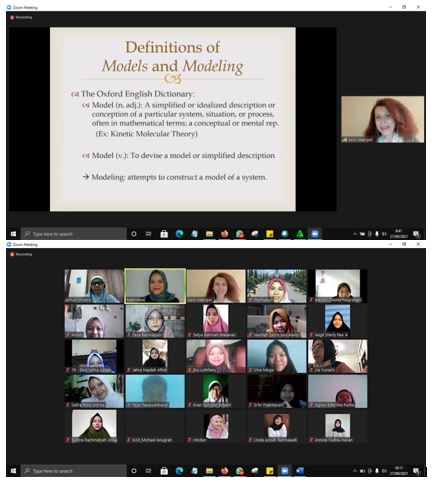 Bahasa Indonesia
Bahasa Indonesia English
English
You are here
Visiting Professor: Assoc. Prof. Dr. Sevil Akaygun - Bogazici University, Istanbul

Chemistry Learning Model is one of the compulsory subjects for Chemistry Education Study Program students, Faculty of Mathematics and Natural Sciences, UNY, which is carried out in the third semester. As a form of implementing the MBKM Curriculum, and preparing graduates who are insightful who are ready to compete globally, the Chemistry Education Study Program organizes Visiting Professor activities. Assoc. Prof. Dr. Sevil Akaygun from the Department of Mathematics and Science Education, Bogazici University, Istanbul, was present as a teacher of the Chemistry Learning Model course, for students of the Chemistry Education Study Program, FMIPA UNY online via Zoom Meeting, Monday, September 27, 2021.
Assoc. Prof. Dr. Sevil Akaygun has experience teaching high school chemistry and science and teaches several courses at Bogazici University, such as the Science Technology Society, Teaching Method in Chemistry, Research Method in Science and Mathematics Education, Inquiry-based Learning, and Media and Methods in Science and Mathematics. Education. On this occasion Assoc. Prof. Dr. Sevil Akaygun delivering material on Models and Modeling in Chemistry Education. Student interaction and participation was built since the beginning of this lecture, such as by utilizing online quiz media, and small group discussions at the breakout room zoom meeting. Students learn about models and modeling chemistry lessons that have been considered abstract. The model becomes a simplified or idealized description or conception of a particular situation or process. Often as a conceptual or mental representation such as a molecular theory. The model used to design simplifies the description of the model, so there is an effort to build a model of a particular system. Modeling chemistry learning can be done by utilizing technologies such as atomic molymod, animated videos about molecules and chemical bonds, or images. Modeling learning can help students understand chemical concepts, but misconceptions can still occur so that understanding concepts and explaining the material in detail to students is one thing that must be considered.
In small group discussion activities, students are invited to analyze the given model: physical, visual, mental. The discussion continued on the students' difficulties in working with the given model through the analysis of the main features or important characteristics of an image of chemical equilibrium. Through this Visiting Professor activity, it is hoped that it can add insight and enthusiasm for Chemistry Education Study Program students as graduates who are ready to compete globally.
Sistem Informasi
Kontak Kami
Program Studi Pendidikan Kimia
FMIPA Universitas Negeri Yogyakarta
Gedung Dekanat D.07 FMIPA UNY
Kampus Karangmalang Yogyakarta 55281
Telp. (0274)586168 Pes. 115
Email: pend_kimia@uny.ac.id
Copyright © 2024,
